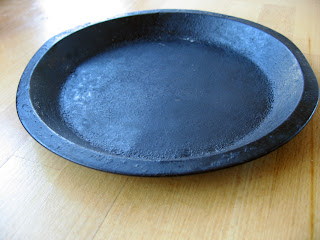- 8am mix the ingredients in the bowl
- 8:10 tip out on to an oiled surface, and stretch and fold the dough 12 times. Clean the bowl. Leave the dough on the worksurface and cover with the bowl.
- 8:20 Stretch and fold the dough 12 times.
- 8:30 Stretch and fold the dough 12 times. Already you can feel a difference. Put the dough in the oiled bowl and cover.
- 9am Tip out the dough on to an oiled worksurface and stretch and fold 12 times. Put the dough in the oiled bowl and cover.
- 10am - same as for 9 am.
- 11am - same as for 9 am.
 At either midday or 1pm (depending on the recipe) I divide the dough into loaf sized pieces (blobs really), and put them on a circular well floured baking tray with a slight lip. Recently I have also been using baking parchment to stop the bread sticking to the tray.
At either midday or 1pm (depending on the recipe) I divide the dough into loaf sized pieces (blobs really), and put them on a circular well floured baking tray with a slight lip. Recently I have also been using baking parchment to stop the bread sticking to the tray.I cover the dough with a mixing bowl, and leave for 4 1/2 to 5 hours, and then bake in a very hot oven for around 30 minutes - depending on the size of the loaf.
Hello. You can definitely save yourself some time here. 8 am mix ingredients together and leave to autolyse, 9am add salt and stretch and fold 4 times, repeat the stretch and fold 3 more times at 15 minute intervals. Leave until fully proofed.
ReplyDelete